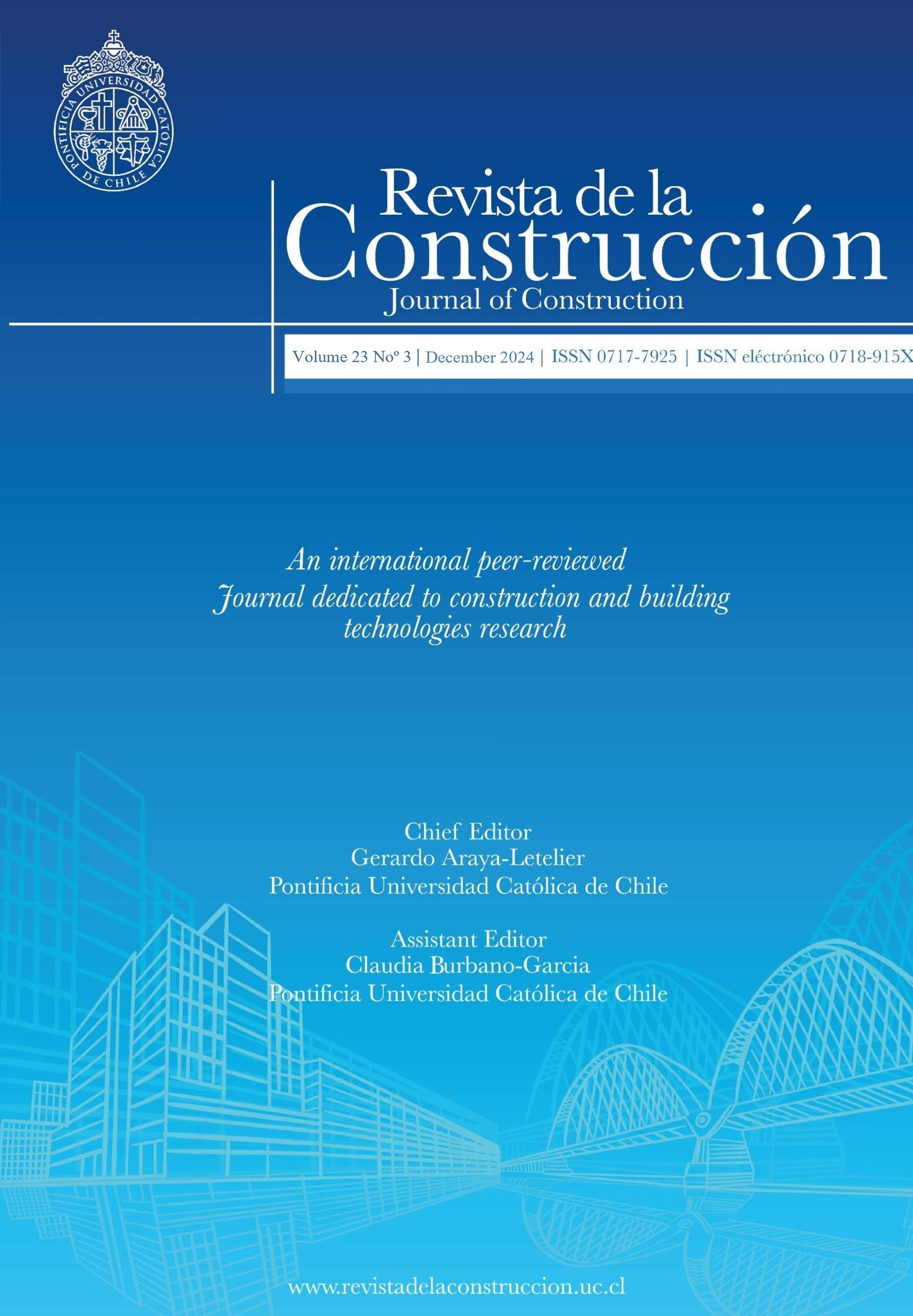Enhancing the mechanical properties of fibre reinforced concrete using diatomaceous earth powder: fresh and hardened properties of concrete
DOI:
https://doi.org/10.7764/RDLC.23.3.457Keywords:
Diatomaceous earth powder, E-waste, fibre reinforced concrete, linear regression analysis, strength properties of concrete.Abstract
This research investigated enhancing the mechanical properties of fibre-reinforced concrete using diatomaceous earth powder. A total of six mix groups were designed as M40 grade concrete according to IS: 10262 – 2019. Each mix group consisted of six mixes. The study examined the fresh and hardened properties of the fibre-reinforced concrete, including workability, Compressive Strength (CS), Split Tensile Strength (STS), Flexural Strength (FS), and Modulus of Elasticity (ME) at various ages. The first three groups incorporated Electronic waste (E-waste) fibres, added to the concrete by weight of cement (0.2%, 0.4%, 0.6%, 0.8%, and 1%) with lengths of 30mm, 40mm, and 40mm, respectively. Additionally, diatomaceous earth powder partially replaced cement in amounts of 5%, 10%, 15%, 20%, and 25%. Based on experimental observations, the optimum fibre content was 0.8% for group 1 and 0.6% for groups 1 & III. Similarly, the same optimum fibre content was used for groups IV-VI. Including E-waste fibres and diatomaceous earth powder enhanced the mechanical properties of the concrete. The experimental study revealed that groups I and VI performed better than the remaining mixed groups. Specifically, for group I, the CS, STS, and FS improved by 9.86%, 4.85%, and 4.96%, respectively, while for group VI, these properties improved by 8.82%, 5.60%, and 4.57%. The physical properties of concrete strength were also compared using linear regression analysis and various codes. The regression equations aligned well with the experimental test results and aided in predicting those results.
Downloads
References
ACI Committee; American Concrete Institute. Building Code Requirements for Structural Concrete (ACI 318-08) and Commentary; American Con-crete Institute: Farmington Hills, MI, USA, 2007; Volume 2007.
Ahmed, A.A.M., Abdel Kareem, K.H., Altohamy, A.M., & Rizk, S.A.M. (2014). An experimental study on the availability of solid waste of mines and quarries as coarse aggregate in concrete mixes. JES. Journal of Engineering Sciences, 42(3), 876-890.
ASTM C 1202-97, Guidelines for diatomaceous earth powder.
Bamigboye, G.O., Effiong, J.U., Ede, A.N., Olukanni, D.O., Okoro, C.W., & Adebesin, J.A. (2024). Review of the use of E-waste in concrete production: challenges and prospects. Emergent Materials, 1-25.
Bashir, A., & Singh, B. (2024). Properties of Concrete on Adding Polypropylene Fibre and Polyvinyl Chloride Fibre. International Journal of Innovative Research in Computer Science & Technology, 12(1), 5-12.
Batayneh, M., Marie, I., & Asi, I. (2007). Use of selected waste materials in concrete mixes. Waste management, 27(12), 1870-1876.
Candassamy, K., Sreerambabu, J., & Sasikumar, P. (2024). A comparative study between linear regression analysis and various codes for predicting the mechanical characteristics of polymer concrete using R-sand and M-sand. Revista de la construcción, 23(1), 129-150.
Dawande, B., Jain, D. & Singh, G. (2016). Utilisation of E-waste as a partial replacement of coarse aggregate in concrete. IJRD, 3(11), 6-9.
Du Beton, C.E.-I. CEB-FIP Model Code 2010; CEB-FIP: Lausanne, Switzerland, 2012.
Gautam, S.P., Srivastava, V., & Agarwal, V.C. (2012). Use of glass wastes as fine aggregate in concrete. Journal of Academia and Industrial Research, 1(6), 320-322.
GB 50010-2010; Chinese Standard Code for Design of Concrete Structures. MOHURD: Beijing, China, 2015.
Günçan, N.F. (1995). Using waste concrete as aggregate. Cement and concrete research, 25(7), 385-1390.
Halahla, A.M., Akhtar, M., & Almasri, A.H. (2019). Utilisation of demolished waste as coarse aggregate in concrete. Civil Engineering Journal, 5(3), 540-551.
Hamada, H.M., Al-Attar, A., Abed, F., Beddu, S., Humada, A.M., Majdi, A., Yousif, S.T., & Thomas, B.S. (2024). Enhancing sustainability in concrete construction: A comprehensive review of plastic waste as an aggregate material. Sustainable Materials and Technologies, 40, e00877.
Hasan, M., & Saidi, T. (2020a). Properties of blended cement paste with diatomite from Aceh Province Indonesia. In IOP Conference Series: Materials Science and Engineering, 796(1), 012034.
Hasan, M., Jamil, M., & Saidi, T. (2023a). Mechanical properties and durability of ultra-high-performance concrete with calcined diatomaceous earth as cement replacement. Journal of the Mechanical Behavior of Materials, 32(1), 20220272.
Hasan, M., Muyasir, A., Saidi, T., Husaini, H., & Azzahra, R. (2020c). Properties of high strength concrete with calcined diatomaceous earth as cement replacement under compression. In Defect and Diffusion Forum, 402, 7-13.
Hasan, M., Riski, A.D.D., Saidi, T., Husaini, H., & Rahman, P.N. (2020b). Flexural and splitting tensile strength of high strength concrete with diatomite micro particles as mineral additive. In Defect and Diffusion Forum, 402, 50-55.
Hasan, M., Saidi, T., & Afifuddin, M. (2021). Mechanical properties and absorption of lightweight concrete using lightweight aggregate from diatoma-ceous earth. Construction and Building Materials, 277, 122324.
Hasan, M., Saidi, T., Jamil, M., Amalia, Z., & Mubarak, A. (2022). Mechanical properties and absorption of high-strength fiber-reinforced concrete (HSFRC) with sustainable natural fibers. Buildings, 12(12), 2262.
Hasan, M., Saidi, T., Mubarak, A., & Jamil, M. (2023b). Effect of calcined diatomaceous earth, polypropylene fiber, and glass fiber on the mechanical properties of ultra-high-performance fiber-reinforced concrete. Journal of the Mechanical Behavior of Materials, 32(1), 20220275.
Hasan, M., Saidi, T., Muyasir, A., Alkhaly, Y.R., & Muslimsyah, M. (2020a). Characteristic of calcined diatomaceous earth from Aceh Besar District-Indonesia as cementitious binder. In IOP Conference Series: Materials Science and Engineering, 933(1), 012008.
Hasanzadeh, B. & Sun, Z. (2018). Impacts of diatomaceous earth on the properties of cement pastes. Journal of Building Materials and Structures, (2), 197.
Mohammed, I., Abdul Nariman, N., Othman Ahmed, K., Ali, S., Mohammed, P., & Samad, S. (2020). Utilisation of waste plastic and waste glass together as fine and coarse aggregate in concrete. Eurasian Journal of Science & Engineering, 6(2), 1-10.
Iravani, S. Mechanical Properties of High-Performance Concrete; American Concrete Institute/ACI Special Publication: Farmington Hills, MI, USA, 2010; Volume SP-128, pp. 416–426.
IS – 10262: 2019; Concrete Mix Proportioning Guidelines. Bureau of Indian Standards: New Delhi, India..
IS – 456: 2000; Plain Concrete and Reinforced, Bureau of Indian Standards: New Delhi, India, 2000.
IS – 516: 1959; Method of Tests for Strength of Concrete. Bureau of Indian Standards: New Delhi, India.
IS: 12269-1987, Ordinary Portland cement (OPC) 53 grades.
IS: 383-2016, Fine and coarse aggregate specification, Bureau of Indian Standards: New Delhi, India.
Jittamaro, P., Maho, B., Pongsopha, P., Nicomrat, D., Jamnam, S., Makul, N., & Sua-iam, G. (2024). Enhancing the usability of electronic waste fibers in high-performance self-compacting mortar incorporating corn cob ash and silica fume: Fresh and hardened properties. Construction and Building Materials, 416, 135194.
Johnston, C.D. (1974). Waste glass as coarse aggregate for concrete. Journal of Testing and Evaluation, 2(5), 344-350.
Kipsanai, J.J., Wambua, P.M., Namango, S.S., & Amziane, S. (2022). A review on the incorporation of diatomaceous earth as a geopolymer-based con-crete building resource. Materials, 15(20), 7130.
Kou, S.C., Zhan, B.J., & Poon, C.S. (2012). Feasibility study of using recycled fresh concrete waste as coarse aggregates in concrete. Construction and Building Materials, 28(1), 549-556.
Li, J., Zhang, W., Li, C., & Monteiro, P.J. (2019). Green concrete containing diatomaceous earth and limestone: Workability, mechanical properties, and life-cycle assessment. Journal of cleaner production, 223, 662-679.
Lokeshwari, M., Ostwal, N., Nipun, K.H., Saxena, P., & Pranay, P. (2019). Utilisation of waste plastic as partial replacement of fine and coarse aggregates in concrete blocks. International Research Journal of Engineering and Technology, 6(9), 378-382.
Maharani, E.A., Hasan, M., & Saidi, T. (2023). The resistance of high-strength concrete with ramie fiber using diatomaceous earth to high temperatures. Materials Today: Proceedings.
Manjunath, B.A. (2016). Partial replacement of E-plastic waste as coarse-aggregate in concrete. Procedia Environmental Sciences, 35, 731-739.
Mishra, K., Siwal, S.S., & Thakur, V.K. (2024). E-waste Recycling and Utilisation: A review of current technologies and future perspectives. Current Opin-ion in Green and Sustainable Chemistry, 100900.
Monish, M., Srivastava, V., Agarwal, V.C., Mehta, P.K., & Kumar, R. (2013). Demolished waste as coarse aggregate in concrete. Journal of Academia and Industrial Research, 1(9), 540-542.
Parsons, L.A., & Nwaubani, S.O. (2024). Abrasion-wear resistance of precarbonated and water-cured concrete made using ABS plastic derived from waste electrical and electronic equipment. Cement and Concrete Research, 179, 107470.
Pavlík, Z., Pokorný, J., & Záleská, M. (2017). The use of diatomaceous earth in production of foamed fine-grained concrete. International Multidiscipli-nary Scientific GeoConference: SGEM, 17, 449-456.
Rahal, K. (2007). Mechanical properties of concrete with recycled coarse aggregate. Building and Environment, 42(1), 407-415.
Rao, D.P., & Desai, P.S. (2014). Experimental investigations of coarse aggregate recycled concrete. International Journal of Advances in Engineering & Technology, 7(5), 1522.
Saidi, T., Hasan, M., Riski, A.D.D., Ayunizar, R.R., & Mubarak, A. (2020). Mix design and properties of reactive powder concrete with diatomaceous earth as cement replacement. In IOP Conference Series: Materials Science and Engineering 933(1), 012007.
Sekar, T., Ganesan, N., & Nampoothiri, N.V.N. (2011). Studies on strength characteristics on utilisation of waste materials as coarse aggregate in concrete. International Journal of Engineering Science and Technology, 3(7), 5436-5440.
Sharma, N., Sharma, P., & Parashar, A.K. (2022). Use of waste glass and demolished brick as coarse aggregate in production of sustainable concrete. Materials Today: Proceedings, 62, 4030-4035.
Sonawane, T.R., & Pimplikar, S.S. (2013). Use of recycled aggregate concrete. IOSR Journal of Mechanical and Civil Engineering, 52(59).
Srivastava, V., Gautam, S.P., Agarwal, V.C., & Mehta, P.K. (2014). Glass wastes as coarse aggregate in concrete. Journal of Environmental Nanotechnolo-gy, 3(1), 67-71.
Wang, J.Y., De Belie, N., & Verstraete, W. (2012). Diatomaceous earth as a protective vehicle for bacteria applied for self-healing concrete. Journal of industrial microbiology and biotechnology, 39(4), 567-577.
Yong, P.C., & Teo, D.C.L. (2009). Utilisation of recycled aggregate as coarse aggregate in concrete. Journal of Civil Engineering, Science and Technology, 1(1), 1-6.
Downloads
Published
How to Cite
Issue
Section
License
Copyright (c) 2024 Gokulkannan N., Manju R., Sasikumar P.

This work is licensed under a Creative Commons Attribution-NonCommercial-NoDerivatives 4.0 International License.








